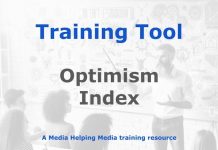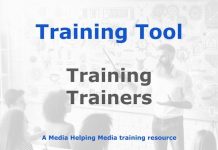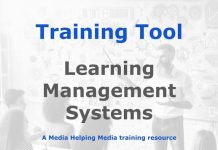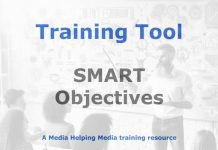
A well-designed media training plan could make the difference between the success and the failure of a media business.
Get it wrong and you could be compounding the problems you were asked to address, get it right and you could release talent, energies, productivity and revenue-generation that was being left untapped.
In the article ‘Maximising the impact of media training’ we looked at the importance of the research part of the media training process.
This is the crucial discovery period where the real training needs of the company are unearthed in terms of staffing, management and workflows.
In this article we look at the importance of spending enough time analysing the research in order to design a training plan that addresses those needs.
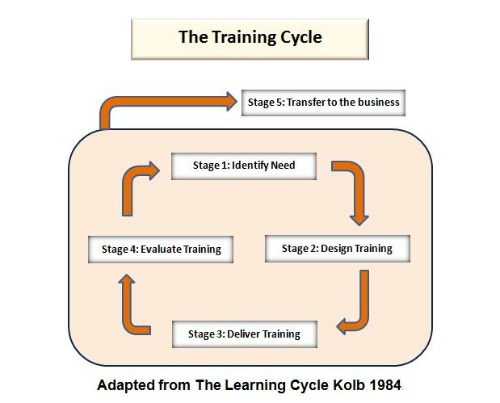
The design part involves creating solutions to the issues/problems you have identified during the research phase including: what you plan to do, why you plan to do it, what the likely impact of your training might be, how the expected resulting improvements might be implemented, how the business might be affected, when the training might take place, who will need to be involved etc.
This is always more work than expected and, in general, you will need to allow at least three days preparation for one day of training – perhaps more.
1: Addressing the issues
The key is ensuring that all the issues that came to light during the research stage (when you spoke to senior management and watched the workflows) are addressed in your training design.
It needs to be logical, and the flow needs to make sense to both senior managers and also to those who are going to be receiving the training (of course that may also include senior managers).
Start by listing all the issues you identified by writing a headline and a summary note for each. This will provide the framework (structure) for your training design.
Once you have that outline you can start to flesh out each point out into a presentation/session dealing with each issue.
If you have any pictures of the actual workflows, and people involved all the better; these will come in extremely useful for the presentations and will make your training relevant as well as offering an element of familiarity.
The high-level framework headlines and summaries will also come in useful when you present your suggested training design to senior manager for their sign-off (agreement).
2: Fresh and relevant material
Once you have the outline for your training design, you can start to expand each topic. At this point it is important to create new material.
You may have carried out similar training elsewhere in the past, but don’t presume that those solutions will work in your new environment.
You owe it to those who are hiring you to rewrite and rework any old material based on the new information you have uncovered at the media house you are now helping.
Past experience is valuable, but each case is different and if it is felt that you are simply reusing old solutions you will soon lose credibility.
Of course, previous tried, tested and proven solutions are valuable, but you will need to show how these can be adapted and made relevant to the job in hand.
It is also important to include the latest industry findings, statistics and trends in your presentations. This means that you will need to be updating your material the night before and the morning of each session to ensure you are up-to-date with developments.
You will also need to display enough expertise on the issues/topics you have identified, and you will need to make sure your suggested solution/approach is valid and relevant.
You will need a thorough understanding of all the steps required in the current business/workflow processes, and must be prepared to be tested on every aspect of your training plan design.
Senior managers (and all in the training pecking order) will need to be convinced that you have a systematic and rigorous proposal that will deliver benefits at every level.
You can’t afford to have any doubts, either in your mind or in the mind of the stakeholders. Uncertainty and a lack of clarity can undermine training – and training that lacks clarity deserves to be undermined.
3: Business objectives
A well-designed training plan will continually refer to the existing business and organisational (agreed) objectives. These will be the reference points for your work. All you suggest will need to relate to these.
This is important because, presumably, all you will be dealing with will be committed to achieving these agreed objectives. Therefore, it will be in the interest of all that the training you deliver is a success – that will provide a great boost to your work, without it you will be starting on the wrong foot.
For some the motivation for attending training will be for personal gain such as promotion and reward, and that is fine. For others it will be because they are keen to help the company move forward, again, another perfectly valid reason. Whatever the motivation, you will need to link all you are proposing to those objectives.
Making each step relevant to the business (and to personal interests) in this way will help as you encourage people to work differently and to adopt your training recommendations. It will also make it easier to sell the project to senior stakeholders when you seek signoff for your proposed input.
Once you have that sign-off it will be much easier to sell your solutions, especially if you can continually relate all you do to the agreed objectives.
You can then drop sentences into your presentations such as “as agreed with senior managers”, or, “in line with agreed objectives” etc.
4: Hearts and minds
Don’t presume that all the stakeholders will be realistic about training.
They may have expectations that you will never be able to meet, or expectations which are not worth meeting (because they are unfocused and irrelevant). However, you can’t tell them that.
Your training design needs to make sense to them, and you can only do this if everything is justified in terms of business benefit.
What you don’t want is to end up in an argument with those you are being asked to help.
They may agree intellectually, but if they don’t feel what you offer is realistic and relevant to their needs they will not offer the support the training needs in order to succeed.
Some may also be afraid of change for a variety of reasons; you need to factor this in, too.
Winning hearts and minds is as important in the boardroom as it is in the newsroom.
Be sure that you have thought through every step and every element and that all you propose to offer the company has earned its place in your planned design on merit.
If there is one manager in the senior pecking order who is not sold on your training plan you are likely to come up against obstacles and resistance.
It is important to establish who is the key stakeholder in the process and ensure s/he wins over any doubters. That is not your job. You can’t afford to get into a fight with the stakeholders.
There needs to be a champion who sponsors your plan and justifies it to all stakeholders as being in the best interest of the company and ensures that it is sold as a concept at every level.
Typically, management will want training to result in a) a more efficient and motivated workforce, b) more productive working practices and workflows, c) a reduction in duplication and wasted resources, and d) a return on investment (ROI).
Regardless whether they have the correct vision or not, they will want to see each of these areas addressed and justified in your training plan.
So you need to design a plan that delivers on all these basics first before you start to inject any fresh thinking or advice on where you feel the training focus should be.
However, if you see a need that is preventing you delivering in the four areas listed above you need to articulate that clearly at the beginning before you head too far down the wrong road.
5: Attention to detail
Your training design needs to not only cover the strategic, but it also needs to cover the detail.
Dates, times, breaks, size of room, desk layout, equipment, power leads, pens, paper, travel time, cost (including time off work) etc. All the boring stuff needs to be factored in.
There is nothing that can be too trivial for your training design. And never take things for granted, such as a power lead with two sockets for your laptop and your projector, or a spare projector lamp should one blow.
Such training design detail can be a one-off and this is one part of the project that can, usually, be transferred from one training event to the next with little to no change.
But do it well. It is amazing how much of a confidence booster it is to have everything in place and working.
You will also need to include an outline of the following elements:
- Interactive exercises: both individual and group
- Presentations: the amount of trainer input and its scope
- Simulations: where you get the whole group working on a project
- Group discussions: the number and frequency of debates with the group
- Pre-course reading: setting out the material required and knowing how it will be distributed
- Questionnaires: Any skills audits or questionnaires (and how they will be distributed, collected and analysed).
